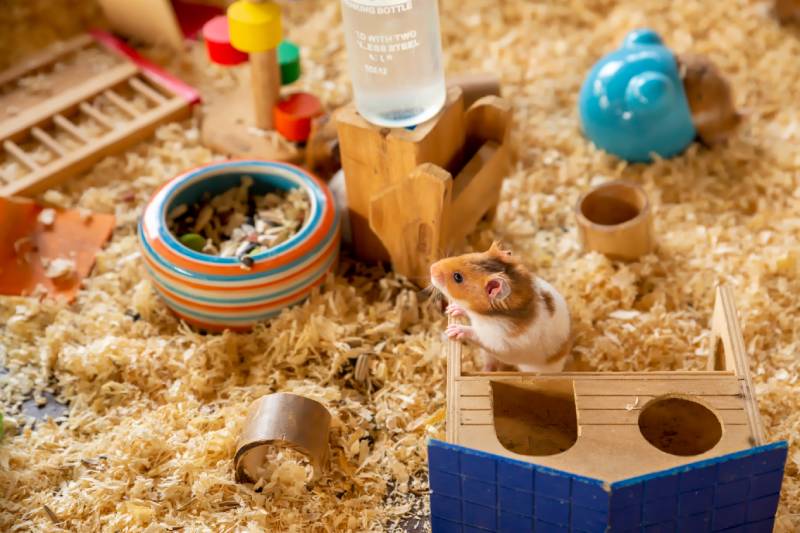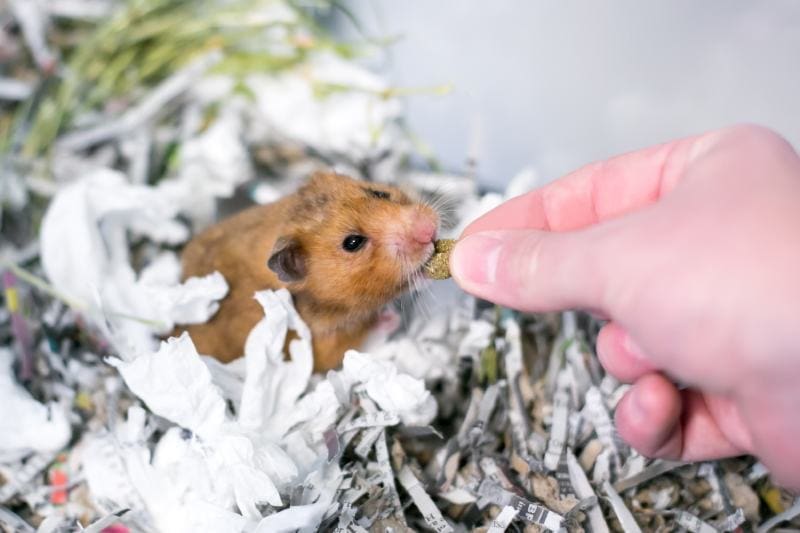How to Find a Lost Hamster Quickly: 12 Expert Tips

Updated on

Click to Skip Ahead
Hamsters are notorious for wandering off when you’re playing with them or simply escaping from their cage. If they were bigger and less susceptible to injury, this might not be a problem. However, they’re delicate animals and get hurt easily, so you should try to find them as quickly as possible.

Before You Start
Here are a few things to keep in mind while you search.
Stay Calm
It’s easy to freak out when you see that your hamster is missing from their cage. They’re small and delicate and can get hurt easily. If you also have a cat or a dog in the house, your hamster’s disappearance is even more concerning.
The most important thing to do is to stay calm. If you start ransacking the room to find your hamster, you run the risk of scaring or hurting them. Stay calm, and plan a methodical approach to your search to keep them safe.

Be Prepared to Look Everywhere
You’ll need to put a great deal of effort into finding your hamster, which means looking everywhere you can think of. Hamsters love to hide and burrow into things. They also return to their favorite hiding places, so you’ll likely need to look at places that you’ve already checked, just in case.
Check under and behind furniture, the fridge, the oven, and other appliances. Drag everything out from beneath the bed, and sort through all the shoes in the entryway. You’ll also need to rummage through purses, rucksacks, coat pockets, books on bookcases, or cushions on couches.

The 12 Tips on How to Find a Lost Hamster
1. Recruit Family Members

The easiest way to search quickly is to recruit help. Ask your family members to assist you. Create a plan of action and designate a room for everyone. Make sure they know to be as quiet as possible and where to search.
You can also employ the help of your dog or your cat, provided that you keep them leashed and observe them. Be careful that your other pet doesn’t scare your hamster. If you don’t trust your cat or dog to listen to you, it’s best to keep them out of the way until your hamster is safely back in their cage.
2. Search at Night
Finding your hamster quickly means thinking like a hamster. Besides considering their favorite places to hide, consider when they’re most active. Hamsters are nocturnal, so staying up late to search for them is your best chance at catching them wandering around your home.
Night time, when everyone’s asleep, is also a great time for hamsters to explore, since it’s less noisy and scary in the house. You’ll need to encourage their exploration by searching quietly.
3. Use a Flashlight

There are going to be many dark places to search when you’re looking for your hamster. It’s also a good idea to turn off the lights and be as quiet as possible, which can make navigating your home dangerous.
A flashlight will work wonders, and it’s a great way to look into places that are too dark for other light sources to reach. You’ll need to use one that is bright enough to give you a clear view and make sure the batteries are strong enough to last a while or keep more in your pocket just in case. Your search might take a few hours.
4. Leave the Cage Door Open
Making sure the cage door is shut is likely a force of habit, but when your hamster is lost, it’s always best to leave the door open. Some hamsters have been known to return home on their own once they’ve finished exploring.
If they’ve escaped from their cage because they were frightened by something around it, they might not return on their own, but it’s worth a shot. Try to remove anything that might have scared your hamster to create a less stressful environment for them.
5. Start by the Cage

The fastest way to find your hamster is to be as methodical as possible, which means starting from their last known location. This will either be their cage or the room that you were in when you were playing with them. If you didn’t see them escape, always assume that they’ve only just got out of their cage and haven’t managed to scurry too far away.
Make sure you check everywhere inside the cage first and then further afield. Check drawers, behind and under furniture, and inside anything that your hamster could climb into. If there are any holes in the walls, consider those too.
6. Sit and Listen
Hamsters might be small, but they can make a great deal of noise when they’re exploring. This is another reason that you need to stay calm during your search. The more you scare your hamster, the more likely they are to hide somewhere and not move until they feel that the threat has gone away.
Take a deep breath, turn off the lights, sit still for a while, and listen. This can be difficult when you just want to rush around and find your hamster as fast as possible. Listening might not sound like an active way of searching, but it’s effective, especially at night when your hamster is most active.
7. Expand Your Search Area

Once you’ve checked everywhere around the cage, have listened for a while, and are certain that your hamster is not in the room, you can start searching the rest of the house. Continue to use the cage as a central point, and work your way outward.
Do the hallway or neighboring rooms first, and then move on to rooms that are farther away. Along the way, make sure you search everything. It’s hard work and tiring, but hamsters can get into anything, even things that you might not expect. You might still miss them, but the more thorough you are, the more likely you’ll find them.
8. Set Out Food and Water
Hamsters are foragers and will search for food and water whether they’re inside or outside their cage. They might have hidden food in their cheeks before escaping that they’ll eat when they need to, and despite their size, they can go a few days without eating or drinking anything at all.
It’s still a good idea to leave out food and water for your hamster if it’s taking you a while to find them. This can help them survive outside of their cage, as long as there aren’t other threats around, such as free-roaming pets.
9. Use Special Treats

Food can work wonders for enticing hamsters out of their hiding place. They’re also likely to return to places that they know they can get food from. This can help you keep them in one room until you find them or give yourself a spot to sit and wait for them to show up.
Combined with other methods, you stand a good chance at luring out your hamster, making sure they get fed, and finally returning them to their cage where it’s safe.
10. Use Aluminum Foil
Hamsters might make noise while they explore, but it can still be difficult to pinpoint their location. Aluminum foil or plastic that rustles easily is a great trick to use. Place either in strategic locations around the house, and set sunflower seeds or a bowl of water in the middle.
Your hamster will have to walk across the foil or the plastic to get to their treats and in the process, will make a noise that will alert you. This approach might not help you catch them, but you’ll hear the rustling and know which room they’re in and that they’re eating or drinking.
11. Use Cornstarch or Flour

An alternative to aluminum foil and plastic is cornstarch or flour. Surround your hamster’s favorite treats or a bowl of water with a ring of cornstarch or flour. Your hamster will have to walk over the flour to reach their snacks and in the process, will leave tracks.
This option might not help you capture them, but it will let you know that they’re still around. It’ll also give you an idea of which room your hamster is in and help you narrow your search.
12. Use Humane Animal Traps
It might sound cruel to trap your hamster, as they’re not pests l, but it is an effective solution. A humane trap will let you continue searching rooms that you’ve already cleared and when you’re asleep or not at home.
Make sure the trap you use is humane, safe, and secure enough that your hamster can’t escape before you can check the trap. You can use a cage with a trap door that swings shut when your hamster goes inside or a bucket trap with a soft blanket at the bottom so they don’t hurt themselves when they fall in. Make sure you check the trap as soon as you wake up or get home.

How Long Can a Hamster Survive Alone?
Your hamster escaping isn’t an immediate death sentence for them. Under the right conditions, some hamsters have been known to show up unexpectedly 3–4 weeks after escaping from their cage. They can also live for 3–4 days without access to food and water.
Unfortunately, their chances of survival vary depending on how much access they have to food and water, whether there’s a cat or a dog in the house, the temperature in your home, the ability to get outside, and other possible dangers.

Conclusion
It’s a great deal of work to find a hamster when they go missing, but your effort will be worth it once you know they’re safe and sound. Searching for your hamster can even be the perfect opportunity to tidy up, which will help clear away any clutter and help you find them faster. Always use a combination of these tips for the best results, especially when you’re asleep or searching in another room.
Featured Image Credit: IRINA ORLOVA, Shutterstock









